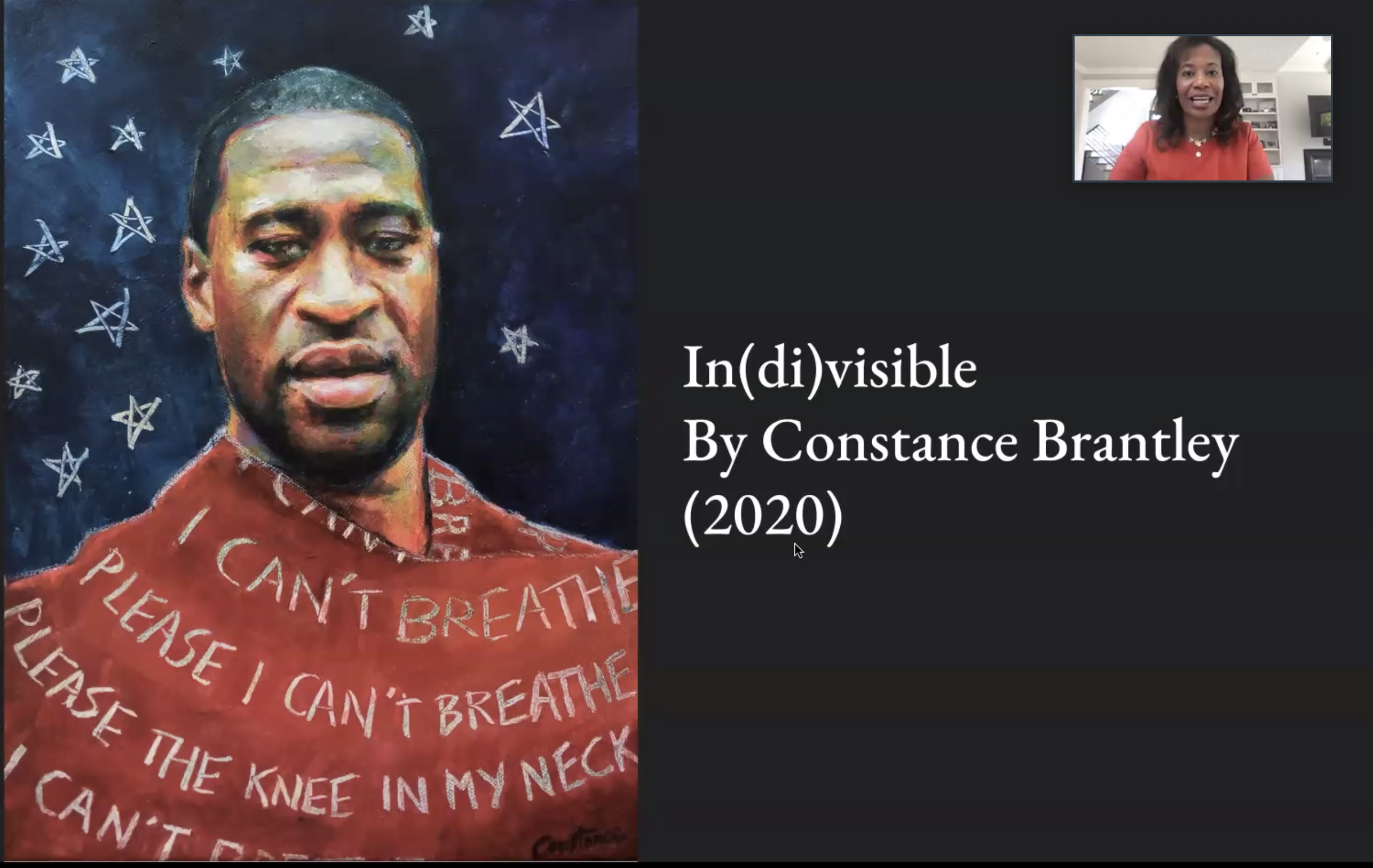Allyson Hobbs began her July 1 webinar on systemic racism and the historical importance of Black Lives Matter by presenting a portrait of George Floyd wrapped in the colors of the American flag with the words “I Can’t Breathe” painted in place of white stripes. The painting, entitled “In(di)visible,” was created by her friend and Los Angeles-based artist, Constance Brantley. Hobbs noted that she wanted to use art, rather than just circulating images of trauma, to prevent the normalization of abuse that Black people face.
Citing Brantley, Hobbs said: “We pledge allegiance to the flag, the emblem of America, which is supposed to provide liberty and justice for all. That liberty, that justice, is supposed to be for all of us.”
“I can almost guarantee you that every day as a kid in school, George Floyd made that pledge to the flag,” she continued. “And what did he get in return?”
In recent weeks, the phrase “Black Lives Matter” has been the rallying cry across streets in all 50 states of America and Washington, D.C., a response to the killing of George Floyd while he was in police custody in Minnesota, as well as the generations of systemic racism Black Americans have faced. His death turned police violence into a lasting national conversation.
“No matter how painful or disorienting it might be, we can turn to history in the same way we might turn to an old friend or parent or a wise, older relative who can comfort us and reassure us that they too have been through wrenching and heartbreaking and even cataclysmic times,” Hobbs said. “And they survived them, and we will too.”
The history that led up to now
According to Hobbs, we are “experiencing multiple pandemics occurring simultaneously.” Not only are COVID-19 cases increasing drastically, but so are deaths and unemployment. On top of it all, George Floyd’s death has highlighted the perseverance of police violence and systemic racism in America.
The wave of protests and uprisings are not the response to just one death, Hobbs added, but rather “a reckoning long in the making.” George Floyd’s name has become a metaphor for the stacked inequalities of the society that produced them.
“Certain conditions continue to exist in our society which must be condemned as vigorously as we condemn riots,” Hobbs said, citing Martin Luther King’s speech, “The Other America.” “But in the final analysis, a riot is the language of the unheard. And what is that, that America has failed to hear?”
She then highlighted that America demonstrates how inequality still exists and can be found in “morbidity, infant mortality, wealth and unemployment” as constructed by society.
“For Black people, there has been an enduring sense that they are not getting the benefit of their humanity,” she added.
Hobbs analyzed Frederick Douglass’ narrative and the abuse that Black people faced in the 1840s while he was advocating for the abolition of slavery. Hobbs emphasized how long this abuse has gone on, and how Black people continue to be victims of it.
Even into the 1960s and the Civil Rights movement, Hobbs noted different instances where Black people were killed — four girls killed in a church bombing, the death of Rodney King in 1990 by police — ultimately underlining the pattern of death of Black people that has become normalized today.
“We are used to watching Black bodies getting beaten and finding almost a kind of sport in that… believing myths in Black ability to bear pain and suppress grief,” she said.
Why is this time different?
Hobbs explained that the public’s reaction “has been produced by years and years of pent up rage… We are watching the simmering and the boiling over of conditions and inequalities that have not been resolved.”
She pointed specifically to a recent Monmouth University poll which found that 76% of Americans (and 71% of white people) considered racism and discrimination to be a “a big problem” in the United States.
She listed several results of the protests, such as the passing of No-Knock Warrants, movements to defund the police and the reconsideration of the utility and necessity of police forces. “Black Lives Matter” has been painted on the streets in locations with histories of prejudice and slavery.
“If there is one lesson that history teaches us, it is that history is always changing,” Hobbs said. “We can’t give up and say that nothing ever changes because it really does.”
“[This movement] has shown that when the state fails, when there is such an utter lack of moral leadership, people of all backgrounds come together and fill that gap,” she concluded.
Contact Elizabeth Wilson at elwilson ‘at’ s.sfusd.edu.
